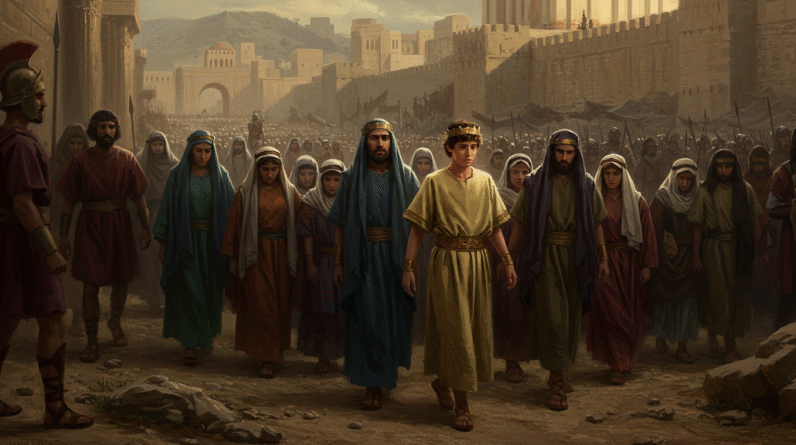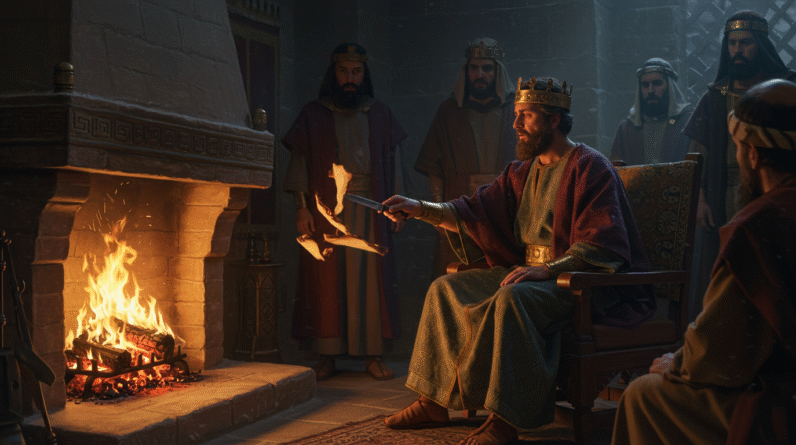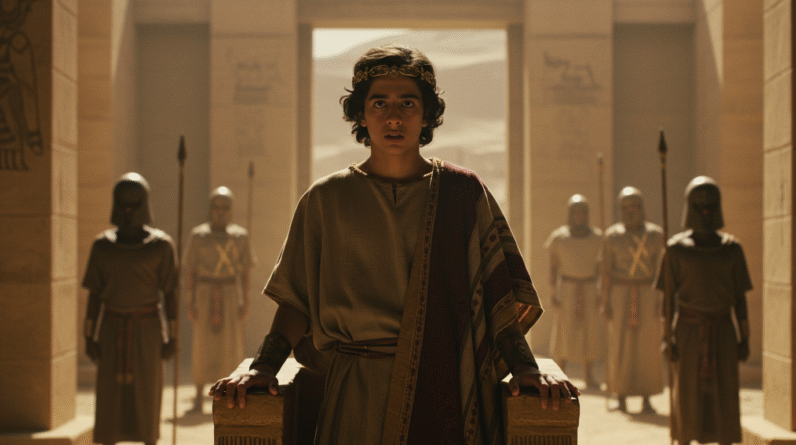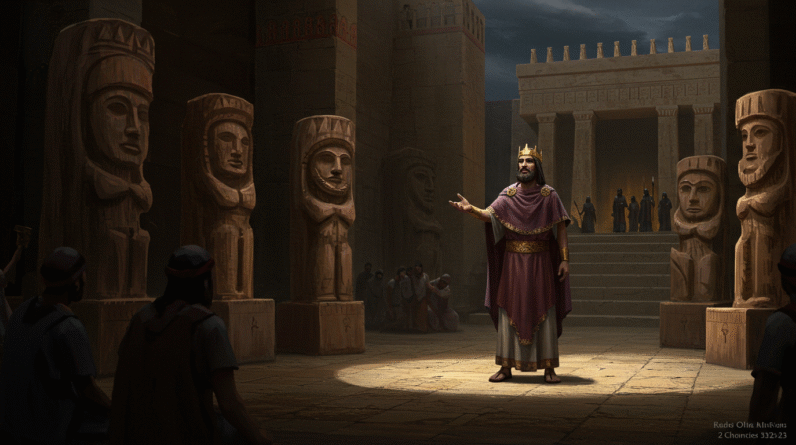Manasseh: Judah’s Most Wicked King Who Found Mercy (2 Chronicles 33:12–13)
You probably know the outline of the story before you look it up: Manasseh reigns long, does awful things, and yet, in the end, finds a kind of mercy. That’s the thumbnail. But thumbnails always flatten. If you let the story breathe — if you sit with it for a while and follow the strange arcs of power, faithlessness, captivity, and return — you’ll see how it’s not just an ancient episode about a bad king. It becomes about how you and the people around you handle influence, sin, humiliation, and the possibility of turning back.
The passage that frames this whole turnaround is brief and blunt: 2 Chronicles 33:12–13. Read it slowly; the compression is part of what makes it so disarming. The Chronicler says Manasseh humbled himself greatly, sought the Lord, and the Lord was moved by his plea and brought him back to Jerusalem to his kingdom. That’s the pivot. You can follow the verse here: 2 Chronicles 33:12–13.
Who was Manasseh?
You can picture him a dozen ways: an insecure heir, a child of a pious father, a man intoxicated with power, or simply a historical figure whose life happens to read like a cautionary tale. The biblical sketch tells you he began to reign at a very young age; his father, Hezekiah, is remembered for reform and faithfulness, and the contrast between those two reigns is almost theatrical. See his introduction: 2 Chronicles 33:1.
You should notice that detail — the generational shift. You watch a father clean the house and the son sell the furniture. That’s not unique to monarchies; it’s ordinary human living. But the chronicler makes a point of it because this difference explains why Judah’s life, liturgically and morally, takes a turn. The narrative cares about what leaders do because leaders change public practice: they change altars, they change policy, they change what people think is permissible.
The depth of his wickedness
The text stares at you and names deeds that make the reader wince: Manasseh rebuilt the high places his father had torn down, erected altars to Baal, practiced witchcraft, consulted mediums, built altars in the house of the Lord to all the host of heaven, and even passed his children through the fire, a phrase that, if you know what it means, is terrifying in its implication of child sacrifice. The Chronicler is not coy. You can read the catalogue here: 2 Chronicles 33:6.
There’s a kind of domestic brutality to those details. The text emphasizes not only public idolatry but also the shedding of innocent blood and the corruption of the sacred precincts. You have to imagine the temple itself — its stones carrying the weight of incense, prayers, and covenant — being turned into a place for other gods. That’s more than political apostasy; it’s liturgical vandalism.
The consequences and the prophets
If you’re reading this and wondering where God is in all of this, notice how the story insists there were warnings. Prophets came. Warnings are part of the narrative; they are the narrative’s way of proving that Manasseh’s path wasn’t a sudden surge of wickedness without antecedents. God sent messengers and messages that were refused or ignored. The kings text in 2 Kings emphasizes that God’s patience had been tried and that divine judgment was declared: 2 Kings 21:10–15.
And then something very biblical happens: there are consequences that are political as well as spiritual. In the Chronicler’s version the foreign power — Assyria — takes Manasseh away in chains to Babylon. The humiliation is concrete. This is not merely a moral fall in the abstract; it is a loss of agency, a public stripping of the royal mantle. You can read about his captivity here: 2 Chronicles 33:10–11.
You’ll notice the narrative’s psychological heft here. There’s something about being uprooted and dislocated — dragged, as the language implies — that can break the arrogance of the heart. People who have ruled from gilded palaces are sometimes humbled in dungeons. You might feel impatient reading it: why does it take suffering to move a person? But the chronicler wants you to see that the hard soil of humility sometimes grows the roots repentance needs.
The moment of repentance (2 Chronicles 33:12–13)
And then verse 12 arrives like a quiet in a noisy room: Manasseh humbled himself greatly before the God of his fathers and prayed. The lord was moved by his entreaty and brought him back. The language is simple, almost domestic: he prayed, God heard, God restored. You can read it here: 2 Chronicles 33:12–13.
What’s striking is the abruptness of the emotional turn. You want to know what that prayer sounded like. Did he weep? Did he confess publicly? The Chronicler compresses all of that into a single verb: he humbled himself. You are left to fill in the texture. That compression does a lot of work; it allows you to imagine the private collapse of pride, the internal confession, the kind of repentance that changes trajectory.
You should also notice the theological claim lying behind that move: God responds to genuine turning. The Chronicler’s theology is straightforward: God’s mercy is available; God hears the humbled. That’s why the story is included — it’s not merely an oddity in the historical record. It’s a theological claim about who God is and how God acts when sinners repent.
Restoration — not perfection
Restoration follows: God brings him back to Jerusalem, to his kingdom. The Chronicler then tells you Manasseh removed foreign gods and the altar, and repaired the altar of the Lord, worshiping God again. He’s not rehabilitated into holiness, but he’s given a second act. You can read the chronicler’s description of his reforms here: 2 Chronicles 33:14–17.
You’ll appreciate the odd humility of this reform: it’s not as if Manasseh becomes an icon of righteousness after his fall. The Chronicler is judicious; he records his reformation but not with triumphalism. You can feel in the text a kind of restrained relief — a recognition that power brought him low and prayer lifted him up, but also an awareness that the consequences of his prior reign didn’t simply vanish. The people had been led astray; the social memory of that apostasy persisted.
The tension with 2 Kings: two portraits
If you’re reading between the lines, you will notice a tension. The book of Kings gives you a bleaker portrait: Manasseh is the archetypal evil king; the text ends with condemnation, and there’s no explicit repentance scene like the one in Chronicles. See how Kings sums him up: 2 Kings 21:1–18.
What do you do with that divergence? Historiography matters. Chronicles and Kings have different theological agendas. Kings wants to explain exile as a consequence of accumulated sin, and in that framework Manasseh is a major culprit; Chronicles, written later, offers hope — a reminder that even the worst can be restored if they repent. That’s not forgery; it’s theological editing. The chronicler is shaping memory with an aim: to show that hope and repentance are operative even after catastrophe.
You might be unsettled by the way history is being shaped by theology. But that’s the ancient genre. The Chronicler’s community had reasons for including this story. They needed to believe, under the shadow of exile and return, that repentance could reopen doors. The account is pastoral as much as it’s historical.

Why this matters for leadership
You can take this into your own life if you have any concern about influence. Leaders don’t live in a vacuum. Manasseh’s bad choices rippled through Israelite religion for a generation. When you occupy a position of influence and use it irresponsibly, the harm multiplies. The story is stark: small compromises build into systemic corruption.
You’ll also notice the paradox: power can make humility scarce, but power can also provide the context for a dramatic repentance. That doesn’t excuse abuse; rather, it shows that accountability matters. In the Chronicler’s thought, public leaders are accountable not only socially but spiritually. When they repent, the effects are likewise public. That means when you fail, you don’t get to privately absolve yourself and go on as if nothing happened. The moral ecology of leadership requires public repair.
The hard fact of consequences
Repentance matters, but repentance does not erase consequences — a painful but crucial point. Manasseh’s reforms didn’t undo the fact that he had led the nation into idolatry and violence. The Chronicler doesn’t pretend otherwise. You have to live with the relational wreckage that poor decisions create, and even when you’re forgiven in a spiritual sense, the social and political consequences may linger.
There’s a pastoral lesson here: you can’t treat repentance like a reset button that erases structural harm. Restoration in the life of a leader is real and meaningful, but it doesn’t substitute for restitution and work to repair what was broken.
The theological rhythm: justice and mercy
If you’re wondering how to reconcile the stern warnings with the tender mercy, the narrative gives you a theological rhythm: God’s justice is real; God’s mercy is active. The Chronicler wants you to see both. The prophets warn; the foreign power acts; the humbled are restored. If you look for an overarching scriptural principle, you could turn to other passages that emphasize God’s readiness to forgive those who turn: “if my people, who are called by my name, will humble themselves…then I will hear from heaven and will forgive their sin and will heal their land” — a verse the Chronicler himself quotes as a kind of covenantal echo: 2 Chronicles 7:14.
There are New Testament echoes too: the idea that God’s kindness leads to repentance is not new. Paul writes in Romans about God’s kindness that leads you to repentance: Romans 2:4. The threads run across the canon: call, consequence, repentance, mercy. That cyclical movement is designed to shape communal imagination — to make you both fear the cost of unrepentant sin and to hope in the possibility of restoration.
Practical steps if you’re facing a Manasseh moment
If anything in the story resonates for you — whether you’re the one who’s erred publicly, or you’re watching someone in influence reel — there are practical steps embedded in the narrative’s theology and practice.
First, humility: the text leaves no doubt that real repentance begins with a humbling of the self. That means you have to be willing to let go of status and accept exile — literal or metaphorical — if it comes. Second, prayer and confession: Manasseh prayed; confession is not only privately therapeutic but also spiritually significant. Third, repair and reform: after a genuine turning, there’s practical work to undo what was done. Manasseh removed altars and repaired the temple; you should expect that repentance will compel you to repair relationships and rectify harms where possible. Fourth, accountability: exile is sometimes an imposed accountability; community structures that hold leaders to public standards are a biblical expectation.
You can find scriptural backing for those steps across the Bible: confession and restoration are emphasized in Proverbs and Psalms; consider passages like Proverbs 28:13 about confession and forgiveness: Proverbs 28:13, or the penitential posture in Psalm 51, where brokenness is presented as the honest currency of repentance: Psalm 51:17. Isaiah’s invitation to return to God is also blunt and tender: Isaiah 55:7.
Memory, legacy, and the politics of historical narrative
You might leave the story asking who gets to shape historical memory. Chronicles writes after the exile with the intention of shaping what future generations remember. Why include Manasseh’s repentance? Because the community that survived exile needed a narrative anchor: even the worst king might be restored. That shapes how later readers — you included — read Scripture.
The politics of memory matter because they affect hope. If the only memory you have is of unrelenting judgment, your future imagination is small. If, however, your sacred books include the possibility of turnings and returns, you’re taught to hope for rehabilitation, yours or the community’s. That’s why this story is not merely biographical; it’s pedagogical.
Reading the story with care
Don’t flatten the text into a moralistic bumper sticker. The story resists simple appropriation. It doesn’t say: “Do evil, then confess, then all will be well.” It instead traces a complicated moral geography: sin produces consequences, prophets warn, empires exercise justice, hearts can be changed, God’s mercy is real, and restoration is possible but messy. Read it with the patience of someone who has inherited a long, complicated religious tradition.
You should let the contradictions sit with you. The divergence between Kings and Chronicles is not a problem to be solved with clever harmonization so much as a demonstration that Scripture contains diverse theological emphases. That diversity invites you to hold tension: to take justice seriously and mercy tenderly.
What the story asks of you now
You can walk away from this text with different energies, depending on your place in life. If you wield influence, it’s a reprimand and a consolation: don’t betray the trust placed in you; if you do, know that humility and repair are possible. If you’re on the receiving end of a leader’s failure, the story is both a wounding and a call: demand accountability, and yet, where true repentance occurs, grieve and consider the possibility of restoration.
The Chronicler’s theology invites you to be neither naïve nor cynically unforgiving. You should keep your eyes wide, your standards high, and your capacity for mercy present when it’s genuinely earned. That balanced posture is not sentimental; it’s a survival strategy for communal life that wants both moral integrity and the possibility of rehabilitation.
Final reflections
You will find the story of Manasseh keeps returning to you because it’s about ordinary human patterns: power misused, prophets silenced, exile endured, humility learned, forgiveness given. The biblical witness to Manasseh is not a tidy sermon. It is a mosaic: bright, dark, sharp, and strangely consoling.
If you’re tempted to reduce the story to a single point — “sin leads to exile,” or “repentance guarantees restoration” — resist. Scripture does not let you have that ease. Instead, it asks you to live with complexity: to hold justice and mercy at once, to insist on accountability while leaving room for true change, to be wary of power and to believe in the possibility of return.
Read the central verses again and let them sit: 2 Chronicles 33:12–13. Let them be short and startling. In them, a king who had been the embodiment of the worst of Judah’s sins humbles himself and is heard. Let that tension teach you something about the tragic and hopeful possibilities of human life.
If you want to read the fuller biblical background, compare the Chronicler’s account with the Kings narrative to watch the theological emphases shift: 2 Kings 21:1–18 and the Chronicler’s fuller account in chapter 33: 2 Chronicles 33:1–20. Let both voices instruct you.
Explore More
For further reading and encouragement, check out these posts:
👉 7 Bible Verses About Faith in Hard Times
👉 Job’s Faith: What We Can Learn From His Trials
👉 How To Trust God When Everything Falls Apart
👉 Why God Allows Suffering – A Biblical Perspective
👉 Faith Over Fear: How To Stand Strong In Uncertain Seasons
👉 How To Encourage Someone Struggling With Their Faith
👉 5 Prayers for Strength When You’re Feeling Weak
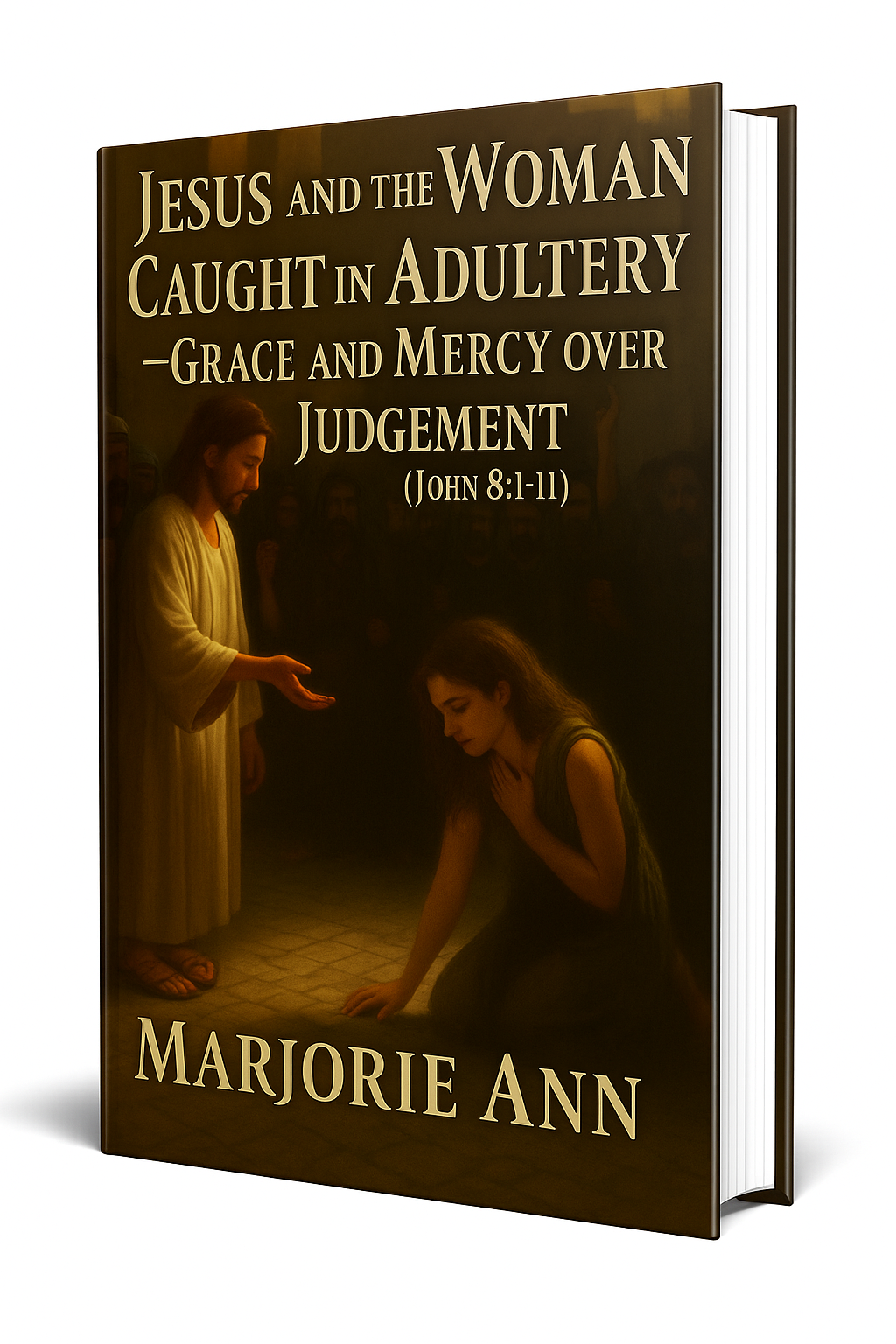
📘 Jesus and the Woman Caught in Adultery – Grace and Mercy Over Judgement
A powerful retelling of John 8:1-11. This book brings to life the depth of forgiveness, mercy, and God’s unwavering love.
👉 Check it now on Amazon
As a ClickBank Affiliate, I earn from qualifying purchases.
Acknowledgment: All Bible verses referenced in this article were accessed via Bible Gateway (or Bible Hub).
“Want to explore more? Check out our latest post on Why Jesus? and discover the life-changing truth of the Gospel!”




